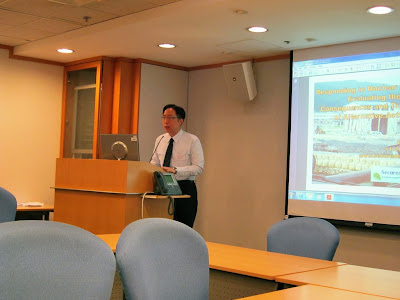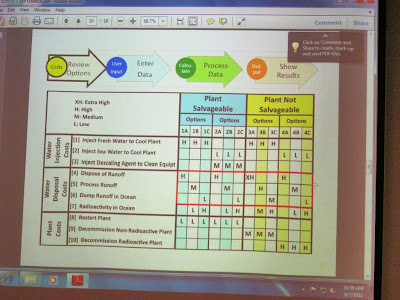The seminar entitled "Responding to Nuclear Releases: Evaluating the Consequences and Trade-Offs of Alternative Actions" was organized by CityU Department of Mechanical and Biomedical Engineering and HKIE Nuclear Division on 7 Sep 2011.
In Japan, the emergency response team at the Fukushima Nuclear Station responded to rising temperatures by dumping sea water (later fresh water) onto the reactors in an attempt to cool them down. It is about 100 million liter of water used onto the reactors to prevent a meltdown. On the other hand, this contaminated water is leaking into environment. This seminar aimed to discuss a new approach to critical decision-making by using a pollutant valuation methodology.

Dr. LUK Bing Lam (Chairman of HKIE Nuclear Division) introduced the speaker Mr. Eddie Leung who is CEO and Founder of Secured Environment, a Silicon Valley-based environmental economic consulting company, founded in 2001. Prior to founding Secured Environment, Mr. Leung led the global environmental strategies in General Electric Company. He is recognized as an Expert in Energy Supply Chain Management and Energy Efficiency Evaluation.
In the beginning, Mr. Eddie Leung gave two questions to start the seminar.
That so many disasters end up costing so much more than initially anticipated??
That salvage values end up being so much less than initially anticipated??
Then Mr. Leung used the total costs of Emergency Coolant of Fukushima Nuclear Station case as a example to explain the relationship of Long Term effect and Short Term effect, as well as, Private cost and Social cost
The total cost of coolant included Delivery, Fire Fighting Opersation, Radioactive Air Emission Abatement, Radioactive Soli Decontamination, Radioactive Water Effluent Processing, Facility Clean Up, Facility Decommissioning, Long Term Monitoring, Compensation, Business Interruption, ... etc.
Mr. Leung said the emergency response window for nuclear accident was only 8hr. If the decision making for this emergency without pre-planning, the cost was much higher.
The diagram demonstrated the value of pollutant coolant.
Mr. Leung developed a new approach to critical decision-making by using a pollutant valuation methodology, which was featured in the 2009 United Nations Climate Change Conference (COP 15) in Copenhagen. A pre-planning emergency shutdown cost was calculated by input all relateds cost into the program and output a real time result for chief executive decision making.
The calculation sample using Fukushima Nuclear Station was shown.
This pollutant valuation tools were able to apply in mobile device such as tablet and mobile phone. Mr. Leung concluded two benefits below:
* Easy-to-Use Pollutant Valuation Tools in a Single Device
During Q&A section, Mr. Leung said the whole supply chain to support emergency action should be considered in pre-planning stage and input all costs into this software tools. And he said the dumping of water/seawater into Fukushima Nuclear Station may not be the best choice. If it meltdown and fixed in the defined location without further leakage, it may be better than the continuous leaking of contaminated water/seawater to the surrounding.
Reference:
HKIE Nuclear Division - http://ne.hkie.org.hk/
Secured Environment Company - http://www.securedenviron.com/contacts.html
The Accident at Fukushima Dai-Ichi Nuclear Power Plant - http://ne.hkie.org.hk/en_it_news_details.aspx?ID=3&&TypeName=What's+new










沒有留言:
發佈留言